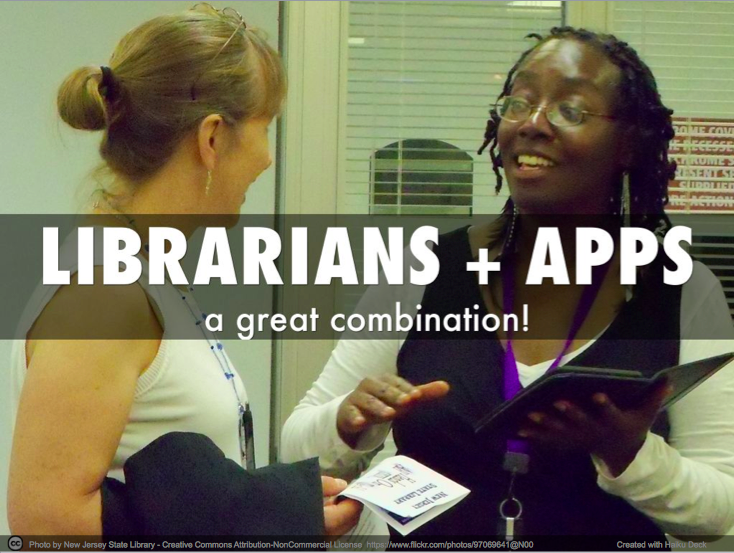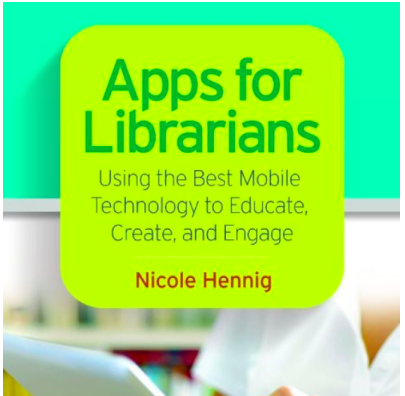
by Nicole Hennig | Mar 28, 2015

There are many possibilities for using apps in creative ways in libraries. In my online course, “The Book as iPad App,” one of the assignments is to participate in a virtual brainstorming activity about this topic.
Librarians in my course are from school, academic, and public libraries, and this list is based on the many creative ideas they came up with. Since this course was focused on interactive book apps, the ideas are mostly about those. Feel free to imagine using these ideas for all types of apps.
The list is grouped into these categories: (more…)

by Nicole Hennig | Mar 20, 2015
I recently learned that Goodreads has a feature where authors can give away free copies of their books in “giveaways” managed by Goodreads. So I signed up. I have 10 copies of Apps for Librarians to give away.
The contest begins on Monday, March 23 and lasts for a month. On April 22 Goodreads will randomly pick 10 entries from all who entered and send me your name and address so I can mail you your free copy. (USA & Canada only)
They don’t have giveaways for ebooks yet, so this is for a print copy. (list price: $45)
It’s not required to review the book, but if you’re a winner Goodreads will encourage it, and I would appreciate your ratings and reviews!
Enter here (or use the button above) — between March 23 and April 22.
by Nicole Hennig | Feb 26, 2015

In my online course, Apps for Librarians and Educators, one of the assignments is to read some of Apple’s iOS Human Interface Guidelines.
These guidelines are for app developers, but it’s also very useful and eye-opening for app users to become familiar with them — especially if you are an information professional or educator who helps others with mobile apps and writes reviews of them.
These are the sections I ask my students to read: (more…)
by Nicole Hennig | Dec 26, 2014
 I’m in the midst of creating a new online course called Organize Your Life with Mobile Apps. If you’ve ever lost important information or forgot to bring it with you, this will help.
I’m in the midst of creating a new online course called Organize Your Life with Mobile Apps. If you’ve ever lost important information or forgot to bring it with you, this will help.
Have you been too busy to find and set up the best apps for organizing your life?
I’ve met many people who tell me they are too busy to set up and use any new apps. They use email, web browsers, Facebook, and a few games on their iPhone or Android smartphone — but not productivity apps. If this sounds like you, this course will help. (more…)
by Nicole Hennig | Dec 26, 2014
 My latest book, Selecting and Evaluating the Best Mobile Apps for Library Services, is now available from ALA TechSource as one of their Library Technology Reports (vol. 50, no. 8)
My latest book, Selecting and Evaluating the Best Mobile Apps for Library Services, is now available from ALA TechSource as one of their Library Technology Reports (vol. 50, no. 8)
Last summer ALA approached me about writing this for their series.
Instead of being a guidebook to over 100 of the best apps like my other book, Apps for Librarians: Using the Best Mobile Technology to Educate and Engage, this one focuses on what you need to know to evaluate mobile apps for educational use.
It includes:
- An overview of app literacy: mobile operating systems, mobile ecosystems, core apps, natural user interfaces, device capabilities, accessibility, and jailbreaking.
- A detailed app evaluation checklist that supplements traditional review criteria for print resources.
- Review sources for keeping up with the newest apps.
- Summaries of iOS features that support accessibility.
- Ideas for library instruction and event-programming with apps.
You can purchase it here.
Want a sample? The publisher offers a free copy of the first chapter (see PDF download link).
See my other titles on the books page of my site.
by Nicole Hennig | Nov 16, 2014
Touch Press makes several wonderful interactive book apps. One of my favorites is Beethoven’s 9th Symphony. Here’s a demo video I made about the app.






